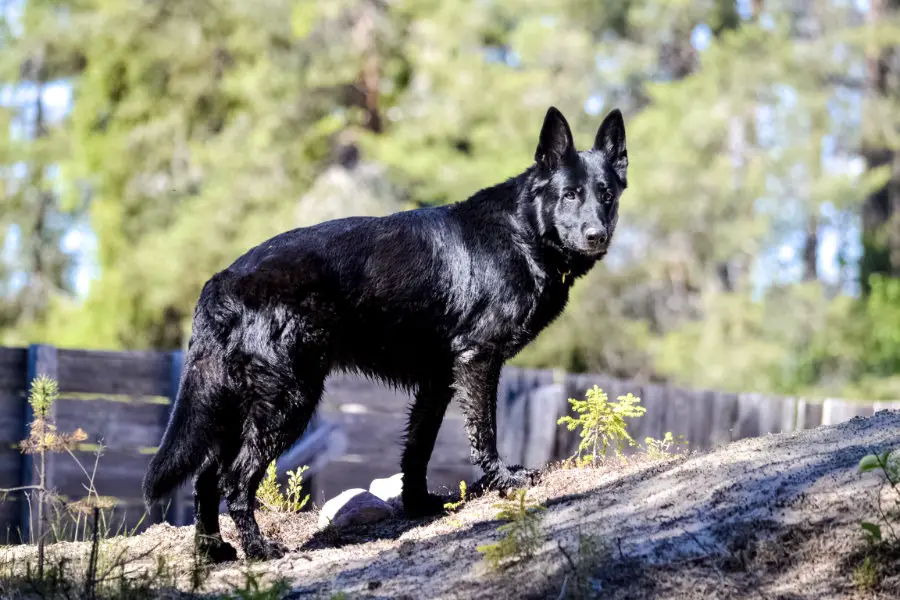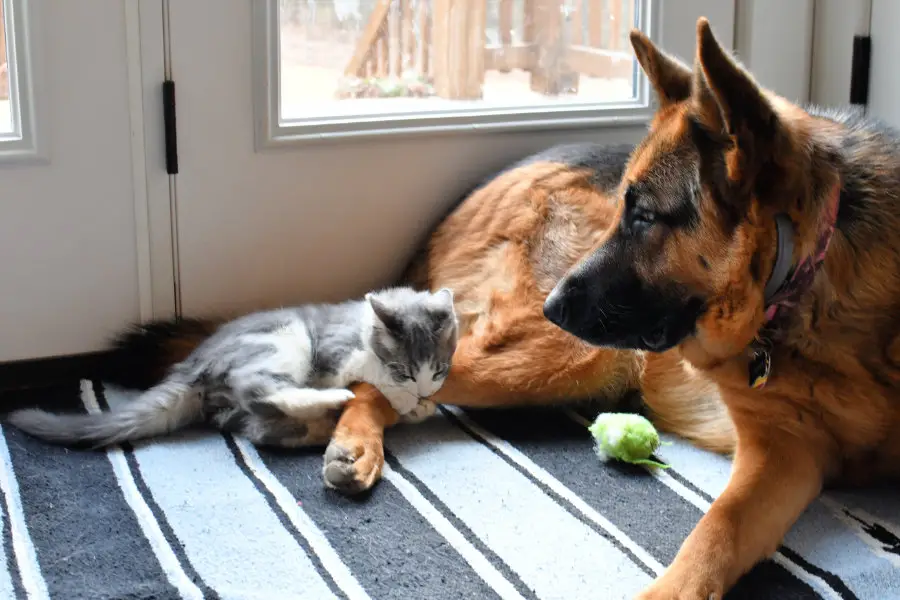By nature, German Shepherds have an intimidating and aggressive appearance, but that does not mean they will destroy any living thing in their presence. German Shepherds, like any dog, can be trained to respect the members of their family or community, including cats.
German Shepherds can definitely kill a cat, simply because of their size and prey drive. However, German Shepherds are not dogs that have an innate instinct to kill cats any more than any other large dog. However, it is important that you observe their behavior carefully, and not try to force a relationship between the two to ensure your German Shepherd will not harm any cats that it may encounter.
Although it could potentially be dangerous to have a German Shepherd around a cat, there are ways you can introduce them to each other to prevent a German Shepherd from accidentally killing a cat.
German Shepherd Nature
German Shepherds are extremely intelligent dogs with a prey drive. Sometimes, this prey drive can cause unfortunate accidents that involve smaller animals such as a cat. While they can be very playful dogs, German Shepherds could become aggressive if not properly trained.
Before you place a cat and a German Shepherd around one another, you need to have a strong understanding of the personality of both animals. This will help prevent any unfortunate events.

What Is Prey Drive?
Dogs are carnivores, and they have an instinctual drive to hunt for their food. This is called prey drive. You must understand the prey drive process so that you know what your German Shepherd may be up to when they are looking at a cat.
Prey drive is sequential and has five steps:
- Searching
- Eye stalking
- Chasing
- Grab bite
- Kill bite
You may notice that these steps resemble how a German Shepherd may choose to play. The difference is the final step of the prey drive—the kill bite. While it may appear to be all fun and games, it can end very tragically if you are not careful.
Can You Stop Prey Drive?
If you notice your German Shepherd exhibiting a strong prey drive that is endangering your cat, you have a couple of options:
- Do NOT leave the two of them alone together. It can appear the two are getting along, but the minute your back is turned, it can all change.
- Work with a trainer to help lessen the chances and gain control of the prey drive.
When dogs have a strong prey drive, it can be incredibly challenging to eliminate it because it’s an instinctual behavior.
Stop The Chasing
The hallmark of the prey drive is the chase. Dogs love to chase anything that moves. Typically, this is fun and it’s a great way to exercise your dog; however, if your dog begins to chase other people or animals, like your cat, this can be problematic.
To help lessen this behavior, you can do the following:
- Make sure your dog is safe and secure. If they have a propensity to chase, it is best to keep them secure and fenced in, where they can run and be safe.
- Work with a professional trainer to help deal with the behavior. If you do not understand where the behavior is coming from, it is going to be difficult to handle. The trainer will likely teach you several strategies to use when you notice your dog moving into prey drive mode.
The strategies used to lessen the prey drive will need to be practiced by you as well, but they should only be practiced in a safe environment until they become natural for both you and your pet.
Can German Shepherds Get Along With Cats?
Can a German Shepherd and a cat really coexist in harmony? The truth is, the two animals can form an extraordinarily strong bond with one another if it is handled correctly. When making the introduction, keep in mind, it may be a long process before your cat and dog become true companions, so stay patient and don’t get frustrated.

These are the steps you can follow to begin the process:
- You must understand your cat’s personality. Cats, by nature, are more sensitive to certain situations and will not easily forget being tormented by a curious dog. If your cat is high strung and does not deal well with prodding, the introduction will need to be much more gradual.
- Cats are natural runners if they feel threatened, make them feel safe. If the cat runs away, it can trigger the prey drive sequence, so you need to eliminate that risk.
- Do NOT allow the German Shepherd to paw at or hit the cat, especially while it is restrained, because this will not give the cat a particularly good attitude toward the dog.
Before you introduce a German Shepherd to a cat for the first time, it would be wise to introduce them to one another by scent. This will allow them to recognize one another when they are in each other’s vicinity.
After properly introducing the two animals and gauging their reaction to one another, it is still important that you do not leave them alone. While they may appear to get along, it is important that they are supervised until you are certain there won’t be any attacks from either side.
What If The Introduction Turns Bad?
When you are in the process of introducing your pets to each other, you need to watch for the signs that indicate the introduction has taken a downward spiral that needs to be stopped immediately.
Some of the key indicators that you need to intervene are:
- The cat appears to be frightened even after the initial introduction. Some signs of this may be hair standing up, growling, or hissing with widened eyes.
- The dog appears overly excited. Sometimes when the prey drive sequence begins, it can be mistaken for overzealous behavior. If you notice this, you need to remove the dog immediately.
- The dog lunges at the cat.
- The cat begins to paw at the dog.
If you notice any of these behaviors, you need to slow down the introduction process and revisit the initial scent-swapping until the two can comfortably be in the same room together. You may need to go through this process several times before the two can be comfortable together.
(Sources: Blue Cross and American Humane)
What If They Do Not Get Along?
Perhaps you have a cat and a German Shepherd that cannot seem to get along. Even after the most gradual introductions and weeks or months of patience, the two just do not get along. If this is the case, you may have to accept the fact that the two will need to coexist separately from one another. While this is not ideal, it is likely the safest situation for both of your pets.
German Shepherds are lovely dogs and are not naturally inclined to kill cats. However, the strength of their prey drive can determine how well they can function with a cat in the home or even a neighbor’s cat that crosses into the yard.
Training can help tame a strong prey drive, but it will never be completely extinguished, which is why you need to use caution when introducing a cat into your German Shepherd’s life.
